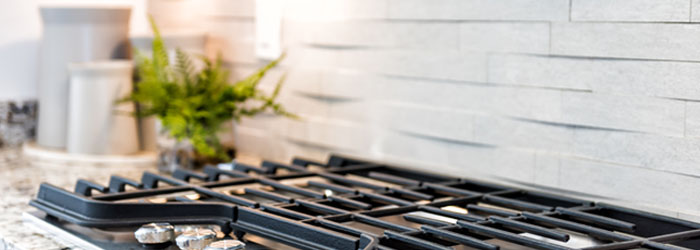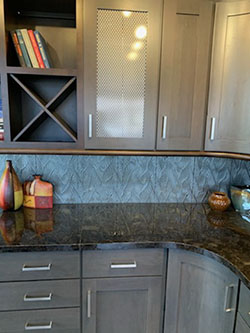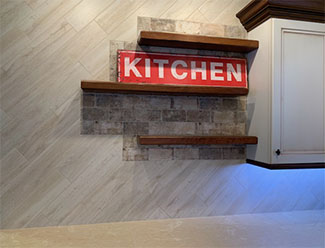Make a Bigger Splash With Backsplash
 09 April 2019
09 April 2019 

7 Ideas to Keep in Mind When Designing a Backsplash
Once upon a time, a backsplash amounted to a few extra rows of tile installed in a kitchen above the cooktop or the sink. It was a way to keep food or water from splashing up on bare walls. But the past few years, the backsplash has become a tempting "kitchen canvas" where homeowners and kitchen designers try out exciting ideas.
Some ideas posted online include: mosaic murals, tiles that seem covered in gold, silver or copper; huge mirrors; 3-D style tiles that make you want to reach out and touch them; shiny sheets of what looks like quartz, marble or granite; even flooring -- luxury vinyl planks – is being laid on kitchen walls. Large sheets of colored glass are also used as backsplashes.
Most often, you might see ceramic subway tiles everywhere in small, medium and large sizes – mostly white but sometimes in color.
Here are seven suggestions about backsplashes for your kitchen:
1. Where a backsplash is installed:
Almost all kitchens built today have at least a 4-inch mini- backsplash above the counters -- all the way around the kitchen walls. Often, this small backsplash is on top of counters and is usually the same material as the counter itself. Larger backsplashes are used above the cooktop and sometimes the sink. They run from the range or sink up to where the cabinets start.
2. Price varies:

Price is based on how much tile you need and what type of material you choose. Cost can generally range from $1,500 to $6,000 according to the Houzz website. Though some homeowners boasted online that they had only spent a few hundred dollars using flooring tiles for a backsplash.
3. Best timing for doing a backsplash:
You can do it whenever it works best for you. Keep in mind that you can do it yourself as a DIY project or you can hire a handyman to do the work for you. If you are planning a full kitchen remodel in the near future, you could save the project and schedule it as part of the remodel as well. Remember, if you select special order tiles for your backsplash, it may take several weeks to receive an order of special tiles or materials you want to use, so plan accordingly.
4. Easy-to-clean tiles or surfaces are probably the best choice:
Ann Lyons, a designer for Rosie on the House Remodeling also tells a story about someone who ended up using real stone in a backsplash but didn't have it sealed. "On the very first night she cooked in her new kitchen, she made spaghetti and wrecked the backsplash," Lyons said.

To avoid problems with stains, you can also seal the grout between the tiles. One popular look is white subway tiles with black or dark grout – a technique that eliminates the threat of staining grout.
5. Think about under-lighting your cabinets:
That's so you can better display your new tile job, according to Reilly. You'll also want to have all outlets and switches perfectly lined up with each other and located in the right places.
6. Removing backslash:
If you want to remove a backsplash you don't like any more, it's more than the tiles you will wreck. Pulling off the tile means you destroy the drywall as well. So make your choice carefully.
7. Colorful backsplash:
If the backsplash and tile on the walls are colorful, you want the countertops to be more neutral. Of course, it's important to choose carefully, but most of all when you're doing a beautiful backsplash, you want to have fun.
What about a do-it-yourself backsplash?
Before you even start your project, visit a tile showroom for inspiration and ask lots of questions. If want to do something dramatic or complicated, you're probably better off having an expert craftsperson install your backsplash.
It's easy to install tile on a cleaned-up, painted wall surface behind counters, sink and range in your kitchen. First, remove any wallpaper. Then sand the surface and clean up dust. Easiest to work with are mesh-backed sheets of mosaic glass or ceramic tiles. Measure your space to estimate how many sheets to buy.

If you haven't ever laid tile before, you could practice setting a few rows of tile on scraps of wood until you can get experienced with grout lines.
When you get the tiles home, measure the area again. Then use masking tape to outline the size and shape of the wall you are covering on a large piece of cardboard laid on the kitchen floor. Lay down the mesh sheets of tiles on that cardboard "map" to see how they will fit the space outlined on the cardboard.
In some cases, you must fill odd gaps with partial sheets or extra tiles. Arrange the extra tiles so they end up in an area where they are less visible. Use a tile saw or carbide nipper if you must cut tiles to make them fit. Use spacers between sheets to keep the joints of equal size.
The trickiest job is smoothly applying thin-set on the wall; then setting the tiles on top of it. If any tiles are slightly concave, apply more thin-set to the back of the tile.
Tools you may need for your backsplash job:
- Pencil
- Tape measure
- Level
- Speed square
- Grout application trowel
- Rubber float to help spread grout
- Grout sponge
- Tile spacers to keep tiles straight and even on the walls
- Notched trowel to apply adhesive to walls
- Power drill
- Mixing paddle
- 5-gallon buckets
- Kneepads
- Safety glasses and earplugs
- Scoring cutter or wet saw
- Handsaw or jamb power saw
- A handheld grout saw
###
Photo Credits:
RELATED CONTENT:
- Rosie eStore: Custom Rosie on the House Tools Every Homeowner Should Have
- Blog: 7 Steps To A Perfectly Done Tile Floor
- Blog: How Much Time Will That DIY Project Take?
- Blog: Possibilities For A Budget-Friendly Floor
- DIY FAQ: Drywall Damage Patch & Repairs
- DIY FAQ: Four DIY Projects That Help Pay For Themselves
- Podcast: Tricks And Tips For A Tile Project
Print this page
recent post
- Duck, Duck, Duct! How Often Should Ductwork Be Cleaned?
- Vinyl vs. Fiberglass Windows: Which Is The Better Choice Of Replacement Window?
- We May Be The Grand Canyon State, But The Rocky Mountains Are Important For Arizona
- Welcome to Arizona! Things A Newbie to Arizona Should Know
- The Pros & Cons of Buying A Flipped House
- Getting In On The Ground Floor
- Why It’s More Critical Than Ever To Get Your AC Serviced Before Summer
- The Reality of Remodeling
- What To Look For When Comparing Your Roofing Quotes
- What To Expect When Buying New Windows & Doors
